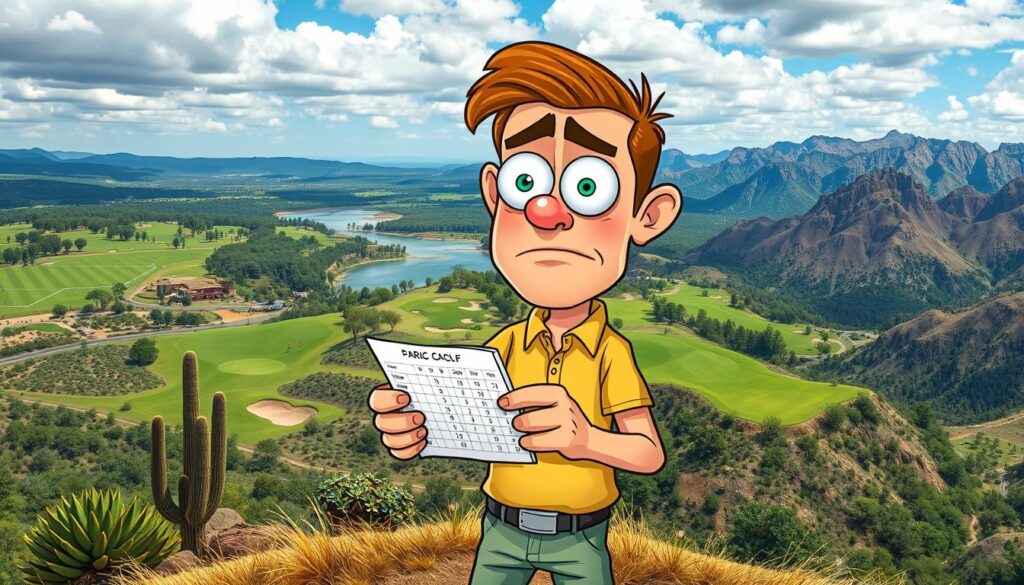Are you ever confused about the golf course rating system? Do you ever wonder what all those numbers mean when you look at a golf course’s scorecard? Let us demystify the rating system and explain what the Slope Rating is and how it affects your golf game. You will be able to get a better understanding and make more informed decisions when choosing which course to play.
Table of Contents
What Does a Slope Rating Say About a Golf Course?
 The slope rating of a golf course measures the relative difficulty of a particular course for a bogey or higher-handicapped golfer versus a scratch golfer. It is expressed as a number ranging between 55 and 155, with higher numbers indicating a more challenging golf course. In order to calculate a golf course’s slope rating, the average score for all players of various skill levels must be taken into account.
The slope rating of a golf course measures the relative difficulty of a particular course for a bogey or higher-handicapped golfer versus a scratch golfer. It is expressed as a number ranging between 55 and 155, with higher numbers indicating a more challenging golf course. In order to calculate a golf course’s slope rating, the average score for all players of various skill levels must be taken into account.
Golfers use a slope rating to gauge how difficult or easy it may be to play on any given course. A higher slope rating indicates difficult terrain with small fairways and accurate shots are necessary in order for players to score well upon their round. Courses with lower ratings are generally considered easier, usually featuring wide open fairways or larger putting greens where longer drives off the tee can go unnoticed.
Understanding what your specific handicap level indicates can create an expectations for your game and if you’re well suited for courses with varying ratings – from beginner friendly par threes up to pro-level championship courses – you’ll be able develop strategies best optimized for those different levels of play style.
Who Determines the Slope Rating?
Slope ratings are provided by members of a local golf association who are trained under the Course Rating System of the United States Golf Association (USGA).
The Course Rating System takes altitude differential, size of the greens, hazard distances, and fairways into account when calculating course ratings for specific courses. In addition, variations among playing conditions in different regions such as dry or wet surfaces are taken into consideration as well.
The evaluation team then plays the course by using GPS and lasers to answer any questions about specific holes. This process results in average scores for a high handicap golfer and a scratch golfer.
Because no two golf courses are exactly alike, it is important to understand what constitutes its slope rating so that you can adequately gauge your ability against its difficulty level before playing it. Knowing this number will help you sort out which courses best suit your game so that you can prepare yourself mentally and physically before tackling any new challenges ahead!
How is a Slope Rating Calculated?
The slope rating of a golf course is a mathematical calculation that helps golfers of varying abilities identify their expected scores for the round.
The formula used to determine the slope rating involves two basic components: the course’s USGA Course Rating (CR) and its Bogey Rating (BR). A team of people from the USGA determines the CR by figuring out how many strokes a scratch golfer would need to complete 18 holes at par. They take into consideration the doglegs, elevation, width of the fairways, water hazards, difficulty of reaching the green, etc. This value can range anywhere from 68-78 (or even higher), although most courses are in the 72-74 range. BR is calculated similarly but for bogey golfers – that is, those whose handicaps fall between 20 and 24.
To calculate the slope rating, you must subtract the USGA course rating from the bogey rating and multiply the result by 5.381 for men and 4.24 for women.
The lower the rating number, typically between 55 and 155 (the USGA’s standard range), the easier it will be for average golfers to achieve good scores as compared to harder courses which would have higher rating numbers. Course designers often aim for an overall ratings in this range, providing enough difficulty without being too punishing. Even within this range however, there will be certain segments that may be significantly tougher than others, making selecting proper club selection important when playing these types of courses.
What is the Average Slope Rating on the PGA Tour?
Have you ever heard the phrase “slope rating” when reading about professional golf courses? This important aspect of a course relates to how difficult it is to play. Knowing what an average slope rating is on the PGA Tour can help you understand why some players excel at certain courses over others.
Slope ratings are calculated from a range of 55-155 and measure how much greater or lesser difficulty a golf course presents for high handicap players, compared to low handicappers. An average rating on the PGA Tour is 113, which indicates most professional courses present a moderate difficulty with some relatively tricky areas. The slope rating takes into account factors such as terrain, roughs, bunkers, water and green speed to accurately reflect the challenge of playing on any given day in any given location.
The USGA (United States Golf Association) controls all aspects of course ratings and have specified guidelines for their calculation by certified raters. These guidelines include an established maximum slope rating tip of 155 and without changes between the men’s and women’s courses – something that was previously based on gender when the system was first implemented.
Ultimately, understanding your personal skill level in relation to an average slope rating gives you realistic experiences when competing against other golfers during competitions or friendly rounds alike. Knowing what an average rating is can also help you prepare for longer rounds or make suggestions for improvement where needed when playing on Amateur Courses as well.
What is the Easiest Slope Rating?
Understanding the slope rating of a golf course is an important part of picking the right course for your gaming needs. Slope rating is a measure of the difficulty and relative challenge of a golf course for an average golfer, and it can range from 55 to 155 on the PGA Tour. On this scale, 55 is considered to be “extremely easy” and 155 is “very difficult”.
The public golf courses that are part of the American Golf Network Courses are affordable and come with a below average slope rating that is more suitable for beginners or those looking to have an enjoyable time while improving their game.
The Oso Creek Golf Course located in Mission Viejo, CA has an 18 hole length of 3,670 yards, a course rating of 57.4, and a slope rating of 95.
The Tecolote Canyon Golf Course located in San Diego, CA has an 18 hole length of 3,161 yards, a course rating of 58.6, and a slope rating of 101.
It should be noted that even though these courses rate as easier than other courses, it still contains plenty of challenge as evidenced by its diverse layout and bunkers that make up much of its terrain.
These courses may offer great competitive play for inexperienced or novice players by strategically placing obstacles like bunkers and trap shots throughout their holes to create manageable yet challenging gaming conditions that should not overwhelm newbies.
By understanding what factors go into calculating the slope rating assigned to each course on the PGA Tour you can quickly find out what works best depending on your ability level or desired level playing field while going out onto any given fairway. Knowing which courses offer lower difficulty levels will give you peace of mind whether you’re setting out alone or planning any kind tournaments with friends or business associates in order to get your putts dialed-in efficiently!
What is one of the Hardest Golf Courses in the United States?
It is important to understand what the slope rating of a golf course means if you are looking for the most difficult experience. Knowing how it works can help you determine the hardness of a golf course so that you can find the correct one for you.
The Slope Rating, which is developed by the Professional Golfers Association (PGA), measures the relative difficulty of a hole and assigns it a number based on that difficulty, ranging from 55 to 155 with 103 being an average slope rating.
According to the U.S. Golf Association, the Ocean golf course on Charleston, South Carolina’s Kiawah Island Golf Resort has a Slope Rating of 155 and course rating of 79.6 because of the endless bunkers and Bermuda grass that stop your shots from rolling.
The PGA utilizes hundreds of data points to differentiate each course’s difficulty level, which includes figuring out their strokes gained statistics, par 3 and 4 averages, among other stats.
The hardest slope rating on the PGA Tour goes up to 155 but what does that mean? This means that for every 100 strokes taken around a golf course rated at 155 would be expected to score higher than that? So basically speaking, if your game is really good, then playing a PGA course with this slope will not be too big of an issue for you. On the other hand if your game is more at the amateur level then playing courses with this slope could prove very challenging and rewarding in some regards as well.
Frequently Asked Questions
Q: What is a slope rating?
A: The Slope Rating is a measure of the relative difficulty of a golf course for a bogey golfer compared to the course rating. It’s based on the average difference between a scratch golfer and a bogey golfer in terms of their scores on a particular golf course.
Q: How is the slope rating calculated?
A: The Slope Rating is calculated by taking into account the length of the golf course, its terrain, the hazards, and the height of the tees. It is then compared to the course rating and adjusted accordingly.
Q: How does the slope rating affect my score?
A: The Slope Rating affects your score by making it more difficult or easier for you to achieve par on a particular golf course. A higher Slope Rating means the course is more difficult for a bogey golfer, while a lower Slope Rating means the course is easier for a bogey golfer.




